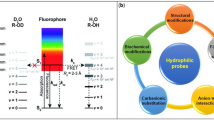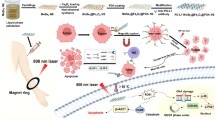Abstract
A unique combination of a specific nucleic acid restriction endonuclease (REase) and atom transfer radical polymerization (ATRP) signal amplification strategy was employed for the detection of T790M mutations prevalent in the adjuvant diagnosis of lung cancer. REase selectively recognizes and cleaves T790M mutation sites on double-stranded DNA formed by hybridization of a capture sequence and a target sequence. At the same time, the ATRP strategy resulted in the massive aggregation of upconverted nanoparticles (UCNPs), which significantly improved the sensitivity of the biosensor. In addition, the UCNPs have excellent optical properties and can eliminate the interference of autofluorescence in the samples, thus further improving the detection sensitivity. The proposed upconversion fluorescent biosensor is characterized by high specificity, high sensitivity, mild reaction conditions, fast response time, and a detection limit as low as 0.14 fM. The performance of the proposed biosensor is comparable to that of clinical PCR methods when applied to clinical samples. This work presents a new perspective for assisted diagnosis in the pre-intervention stage of tumor diagnostics in the early stage of precision oncology treatments.
Graphical Abstract






Similar content being viewed by others
Data Availability
The authors confirm that the data supporting the findings of this study are available within the article and its supplementary materials.
References
Nair M, Sandhu SS, Sharma AK (2018) Cancer molecular markers: A guide to cancer detection and management. Semin Cancer Biol 52:39–55. https://doi.org/10.1016/j.semcancer.2018.02.002
Yang F, Gong J, Li M, Jiang X, Zhang J, Liao M, Zhang H, Tremblay P, Zhang T (2023) Electrochemiluminescent CdS Quantum Dots Biosensor for Cancer Mutation Detection at Different Positions on Linear DNA Analytes. Anal Chem 95:14016–14024. https://doi.org/10.1021/acs.analchem.3c02649
Seijo LM, Peled N, Ajona D, Boeri M, Field JK, Sozzi G, Pio R, Zulueta JJ, Spira A, Massion PP, Mazzone PJ, Montuenga LM (2019) Biomarkers in Lung Cancer Screening: Achievements, Promises, and Challenges. J Thorac Oncol 14:343–357. https://doi.org/10.1016/j.jtho.2018.11.023
Ouedraogo S, Zhou X, Chen H, Chen F, Ma C (2023) Recent advances in biosensors and sequencing technologies for the detection of mutations. Microchem J 185:108306. https://doi.org/10.1016/j.microc.2022.108306
Guo L, Mu Z, Qing M, Zhou J, Li H, Wang L, Zhong M, Bai L (2022) A Novel Signal-On Electrochemiluminescence Immunosensor for the Detection of NSCLC Antigen Biomarker Based on New Co-Reaction Accelerators. Adv Healthc Mater 12:2202287. https://doi.org/10.1002/adhm.202202287
Li Z, Liu R, Lv Y (2021) ICPMS based multiplexed bioassay: Principles, approaches and progresses. Appl Spectrosc Rev 58:1–26. https://doi.org/10.1080/05704928.2021.1918703
Lai RS, Hsu HK, Lu JY, Ger LP, Lai NS (1996) CYFRA 21–1 Enzyme-Linked Immunosorbent Assay: Evaluation as a Tumor Marker in Non-small Cell Lung Cancer. Chest 109:995–1000. https://doi.org/10.1378/chest.109.4.995
Ansari S, Masoum S (2021) Recent advances and future trends on molecularly imprinted polymer-based fluorescence sensors with luminescent carbon dots. Talanta 223:121411. https://doi.org/10.1016/j.talanta.2020.121411
Singh H, Thakur B, Bhardwaj S, Khatri M, Kim K, Bhardwaj N (2023) Nanomaterial-based fluorescent biosensors for the detection of antibiotics in foodstuffs: A review. Food Chem 426:136657. https://doi.org/10.1016/j.foodchem.2023.136657
Han D, Yang K, Sun S, Wen J (2023) Signal amplification strategies in electrochemiluminescence biosensors. Chem Eng J 476:146688. https://doi.org/10.1016/j.cej.2023.146688
Dong J, Yang H, Zhao J, Wen L, He C, Hu Z, Huo D, Hou C, Li J (2022) Sandwich-type microRNA biosensor based on graphene oxide incorporated 3D-flower-like MoS2 and AuNPs coupling with HRP enzyme signal amplification. Microchim Acta 189:49. https://doi.org/10.1007/s00604-021-05141-0
Zhang K, Fan Z, Huang Y, Ding Y, Xie M, Wang M (2022) Hybridization chain reaction circuit-based electrochemiluminescent biosensor for SARS-cov-2 RdRp gene assay. Talanta 240:123207. https://doi.org/10.1016/j.talanta.2022.123207
Zhou S, Guo L, Shi X, Ma L, Yang H, Miao M (2023) In situ synthesized eRAFT polymers for highly sensitive electrochemical determination of AFB1 in foods and herbs. Food Chem 421:136176. https://doi.org/10.1016/j.foodchem.2023.136176
Parkatzidis K, Wang H, Truong N, Anastasaki A (2020) Recent Developments and Future Challenges in Controlled Radical Polymerization: A 2020 Update. Chem 6:1575–1588. https://doi.org/10.1016/j.chempr.2020.06.014
Wang W, Ge Q, Zhao X (2023) Enzyme-free isothermal amplification strategy for the detection of tumor-associated biomarkers: A review. Trac-Trends Anal Chem 160:116960. https://doi.org/10.1016/j.trac.2023.116960
Yang H, Bao J, Huo D, Zeng Y, Wang X, Samalo M, Zhao J, Zhang S, Shen C, Hou C (2021) Au doped poly-thionine and poly-m-Cresol purple: Synthesis and their application in simultaneously electrochemical detection of two lung cancer markers CEA and CYFRA21-1. Talanta 224:121816. https://doi.org/10.1016/j.talanta.2020.121816
Tiwari S, Gupta PK, Bagbi Y, Sarkar T, Solanki PR (2017) L-cysteine capped lanthanum hydroxide nanostructures for non-invasive detection of oral cancer biomarker. Biosens Bioelectron 89:1042–1052. https://doi.org/10.1016/j.bios.2016.10.020
Tamima U, Sarkar S, Islam MR, Shil A, Kim KH, Reo YJ, Jun YW, Banna H, Lee S, Ahn KH (2023) A Small-Molecule Fluorescence Probe for Nuclear ATP. Angew Chem Int Edit 62:e202300580. https://doi.org/10.1002/anie.202300580
Chen G, Qiu H, Prasad CX (2014) Upconversion Nanoparticles: Design, Nanochemistry, and Applications in Theranostics. Chem Rev 114:5161–5214. https://doi.org/10.1021/cr200359p
Wang N, Yang Y, Zhang M, Zhu Q, Li Z (2022) Lysosomal Adenosine Triphosphate-Activated Upconversion Nanoparticle/Carbon Dot Composite for Ratiometric Imaging of Hepatotoxicity. Anal Chem 94(45):15738–15745. https://doi.org/10.1021/acs.analchem.2c03351
Yang Y, Wei S, Wang J, Li J, Tang J, Aaron AA, Cai Q, Wang N, Li Z (2023) Highly sensitive and ratiometric detection of nitrite in food based on upconversion-carbon dots nanosensor. Anal Chim Acta 1263:341245. https://doi.org/10.1016/j.aca.2023.341245
Zhang M, Wang N, Li Z (2022) Recent advances in chromophore-assembled upconversion nanoprobes for chemo/biosensing. TrAC, Trends Anal Chem 151:116602. https://doi.org/10.1016/j.trac.2022.116602
Hou M, Ma L, Yang H, Si F, Liu Y (2023) Background-free and signal-mplified upconversion fluorescent biosensing platform for sensitive detection of CYFRA21-1. Talanta 262:124659. https://doi.org/10.1016/j.talanta.2023.124659
Hlaváček A, Farka Z, Mickert MJ, Kostiv U, Brandmeier JC, Horák D, Skládal P, Foret F, Gorris HH (2022) Bioconjugates of photon-upconversion nanoparticles for cancer biomarker detection and imaging. Nat Protoc 17:1028–1072. https://doi.org/10.1038/s41596-021-00670-7
Rong Y, Hassan MM, Ouyang Q, Chen Q (2021) Lanthanide ion (Ln3+)-based upconversion sensor for quantification of food contaminants: A review. Compr Rev Food Sci Food Saf 20:3531–3578. https://doi.org/10.1111/1541-4337.12765
Hu S, Xu H, Zhou B, Xu S, Shen B, Dong B, Yin Z, Xu S, Sun L, Lv J, Wang J, Xu W, Bai X, Xu L, Mintova S, Song H (2021) Double Stopband Bilayer Photonic Crystal Based Upconversion Fluorescence PSA Sensor. Sens Actuator B-Chem 326:128816. https://doi.org/10.1016/j.snb.2020.128816
Messina MS, Messina KMM, Bhattacharya A, Montgomery HR, Maynard HD (2020) Preparation of biomolecule-polymer conjugates by grafting-from using ATRP, RAFT, or ROMP. Prog Polym Sci 100:101186. https://doi.org/10.1016/j.progpolymsci.2019.101186
Wu Z, Sun DW, Pu H, Wei Q (2023) A novel fluorescence biosensor based on CRISPR/Cas12a integrated MXenes for detecting Aflatoxin B1. Talanta 252:123773. https://doi.org/10.1016/j.talanta.2022.123773
Yan Q, Cao L, Dong H, Tan Z, Hu Y, Liu Q, Liu H, Zhao P, Chen L, Liu Y, Li Y, Dong Y (2019) Label-free immunosensors based on a novel multi-amplification signal strategy of TiO2-NGO/Au@Pd hetero-nanostructures. Biosens Bioelectron 127:174–180. https://doi.org/10.1016/j.bios.2018.12.038
Wang JS, Matyjaszewski K (1995) Controlled/"living" radical polymerization. atom transfer radical polymerization in the presence of transition-metal complexes. J Am Chem Soc 117:5614–5615. https://doi.org/10.1021/ja00125a035
Boyer C, Corrigan NA, Jung K, Nguyen D, Nguyen TK, Adnan NNM, Oliver S, Shanmugam S, Yeow J (2016) Copper-Mediated Living Radical Polymerization (Atom Transfer Radical Polymerization and Copper(0) Mediated Polymerization): From Fundamentals to Bioapplications. Chem Rev 116:1803–1949. https://doi.org/10.1021/acs.chemrev.5b00396
Truong NP, Jones GR, Bradford KGE, Konkolewicz D, Anastasaki A (2021) A comparison of RAFT and ATRP methods for controlled radical polymerization. Nat Rev Chem 5:859–869. https://doi.org/10.1038/s41570-021-00328-8
Hou M, Ma L, Yang H, Si F, Liu Y (2023) Background-free and signal-amplified upconversion fluorescent biosensing platform for sensitive detection of CYFRA21-1. Talanta 262:124659. https://doi.org/10.1016/j.talanta.2023.124659
Joubert F, Musa OM, Hodgson DRW, Cameron NR (2014) The preparation of graft copolymers of cellulose and cellulose derivatives using ATRP under homogeneous reaction conditions. Chem Soc Rev 43:7217–7235. https://doi.org/10.1039/C4CS00053F
Jia M, Chen S, Shi T, Li C, Wang Y, Zhang H (2021) Competitive plasmonic biomimetic enzyme-linked immunosorbent assay for sensitive detection of bisphenol A. Food Chem 344:128602. https://doi.org/10.1016/j.foodchem.2020.128602
Li X, Zhang X, Wu J, Lin N, Sun W, Chen M, Ou Q, Lin Z (2019) Hyperbranched rolling circle amplification (HRCA)-based fluorescence biosensor for ultrasensitive and specific detection of single-nucleotide polymorphism genotyping associated with the therapy of chronic hepatitis B virus infection. Talanta 191:277–282. https://doi.org/10.1016/j.talanta.2018.08.064
Kwon W, Cha B, Kim S, Hwang S, Kim J, Kalimuthu K, Park H, Park K (2019) Fluorescence polarization-based detection of cancer-related mutations using target-initiated rolling circle amplification. Analyst 144:4149–4152. https://doi.org/10.1039/C9AN00429G
Uygun Z, Yeniay L, Sağın F (2020) CRISPR-dCas9 powered impedimetric biosensor for label-free detection of circulating tumor DNAs. Anal Chim Acta 1121:35–41. https://doi.org/10.1016/j.aca.2020.04.009
Cui Y, Niu C, Na N, Ouyang J (2017) Core-shell gold nanocubes for point mutation detection based on plasmon-enhanced fluorescence. J Mater Chem B 5:5329–5335. https://doi.org/10.1039/C7TB01084B
Acknowledgements
This work was supported by the project of tackling of key scientific and technical problems in Henan Province (232102321119, 202102310149).
Author information
Authors and Affiliations
Contributions
Conceptualization, Yanju Liu and Huaixia Yang; methodology, Yanju Liu and Liang Guo; validation, Liang Guo, and Mengyuan Hou; formal analysis, Hiayang Gao.; investigation, Yanju Liu, Huaixia Yang and Fuchun Si; resources, Huaixia Yang and Fuchun Si; writing-original draft preparation, Yanju Liu and Mengyuan Hou; writing-review and editing, Liang Guo and Yuanmeng Ke; supervision, Huaixia Yang; funding acquisition, Huaixia Yang and Yanju Liu. All authors have read and agreed to the published version of the manuscript.
Corresponding authors
Ethics declarations
Competing interest
The authors declare that they have no known competing financial interests or personal relationships that could have appeared to influence the work reported in this paper.
Additional information
Publisher's Note
Springer Nature remains neutral with regard to jurisdictional claims in published maps and institutional affiliations.
Supplementary Information
Below is the link to the electronic supplementary material.
Rights and permissions
Springer Nature or its licensor (e.g. a society or other partner) holds exclusive rights to this article under a publishing agreement with the author(s) or other rightsholder(s); author self-archiving of the accepted manuscript version of this article is solely governed by the terms of such publishing agreement and applicable law.
About this article
Cite this article
Liu, Y., Guo, L., Hou, M. et al. T790M mutation upconversion fluorescence biosensor via mild ATRP strategy and site-specific DNA cleavage of restriction endonuclease. Microchim Acta 191, 148 (2024). https://doi.org/10.1007/s00604-024-06229-z
Received:
Accepted:
Published:
DOI: https://doi.org/10.1007/s00604-024-06229-z




